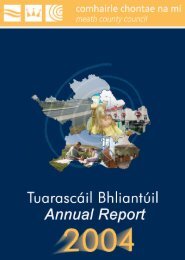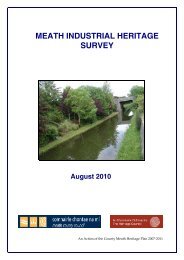Navan Points of Pride Brochure - Meath County Council
Navan Points of Pride Brochure - Meath County Council
Navan Points of Pride Brochure - Meath County Council
Create successful ePaper yourself
Turn your PDF publications into a flip-book with our unique Google optimized e-Paper software.
By the late Middle Ages <strong>Navan</strong> was a partially walled town but the area enclosed<br />
by the wall was relatively small. In 1539, it is recorded that the town’s<br />
defenses were damaged by the native Irish, and <strong>Navan</strong> was described as being<br />
‘not walled nor defensible’. The first settlers ran the town until they were displaced<br />
by the Cromwellian wars. In these turbulent times, the Catholic Nangle<br />
family was replaced by the Protestant Preston family and from 1661, only<br />
Protestants were permitted to serve in the Town Corporation.<br />
Through marriage the Prestons became Ludlows and in 1830, they left their<br />
estate to the Russells, Dukes <strong>of</strong> Bedford. The land was eventually bought out<br />
under the Wyndham Land (Purchase) Act <strong>of</strong> 1903, but some <strong>Navan</strong> Street<br />
names still reflect the Russell family’s connection with the town.<br />
During the 18th century, the Catholic population gradually prospered and when<br />
representative town government was established in <strong>Navan</strong> in 1840, Catholics<br />
came to dominate town life. The 19th century was a time <strong>of</strong> radical change and<br />
shifts <strong>of</strong> fortune in <strong>Navan</strong>. The town witnessed the tragedy <strong>of</strong> the Famine and<br />
the building <strong>of</strong> a <strong>Navan</strong> Workhouse, the rise and fall <strong>of</strong> industry, the coming <strong>of</strong><br />
the railway, and investment in water supply, sewage disposal and architecture.<br />
By the turn <strong>of</strong> the century <strong>Navan</strong> was a modest town, and home to around<br />
four thousand people. <strong>County</strong> buildings were located here in the early 20th<br />
century, and <strong>Navan</strong> became, in effect, the county town <strong>of</strong> <strong>Meath</strong>. The area<br />
prospered as a centre <strong>of</strong> manufacturing particularly <strong>of</strong> furniture and carpets<br />
throughout the 1930s and 40s. Since the 1960s the town has been steadily<br />
expanding and by 2011 the population stood at nearly 30,000.<br />
Recent times have brought further changes to the townscape. The development<br />
<strong>of</strong> Tara Mines (the largest lead and zinc mine in Europe, and the 5th<br />
largest in the world) has attracted wealth to the town, while the many<br />
excellent shops in the town provide plenty <strong>of</strong> opportunity to spend it! <strong>Navan</strong>’s<br />
first shopping centre also moved <strong>Navan</strong>’s urban focus from the historic Market<br />
Square for the first time since the twelfth century. Though the world-famous<br />
<strong>Navan</strong> Carpets factory is long since gone, the famous <strong>Navan</strong> Carpet name lives<br />
on, and the town maintains its reputation for quality furniture.<br />
On this walk, you are invited to trace the town’s past and to experience life in<br />
<strong>Navan</strong> as it is lived today.




